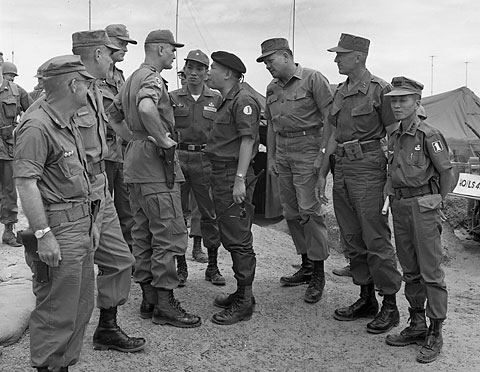 |
|||||||||
|
March/April 2012
Outgunned: The ARVN Under Westmoreland BY LEWIS SORLEY
No single factor more strikingly illustrates Westmoreland’s slighting of South Vietnam’s troops than the M-16 rifle—the new, lightweight, automatic weapon that was considered ideally suited for the Vietnam environment. When improved weaponry and other materiel became available, U.S. forces got them first. For much of the war the South Vietnamese were armed with castoff American equipment of World War II vintage. Meanwhile, the North Vietnamese and Viet Cong received the most modern weaponry their communist patrons could provide, including AK-47 assault rifles. During the Westmoreland years, the South Vietnamese were consistently outgunned, with predictable results in terms of battlefield outcomes and morale, not to mention reputation. “Great emphasis was placed on improving the ARVN constantly,” Westmoreland claimed. But that was simply not the case. The disparity in weapons was acutely apparent during the 1968 Tet Offensive. Col. Hoang Ngoc Lung, South Vietnam’s chief intelligence, recalled: “The RVNAF was equipped with modern weapons only after comparable ones had been employed by the enemy. M-16 rifles were supplied to all RVNAF units only after the 1968 Tet Offensive when the enemy employed communist AK-47s in large numbers.” The recollections of Lt. Gen. Dong Van Khuyen, South Vietnam’s chief logistician, are particularly poignant: “During the enemy Tet Offensive of 1968, the crisp, rattling sounds of AK-47s echoing in Saigon and some other cities seemed to make a mockery of the weaker, single shots of Garands and carbines fired by stupefied friendly troops.” Westmoreland later claimed that in 1964 he had asked his deputy, Lt. Gen. John Throckmorton, to look into “the feasibility of my asking for M-16s for the Vietnamese forces,” and that when Throckmorton recommended against it because of the cost, Westmoreland approved that recommendation, although “with some reluctance.” A year later, after the initial large-scale battles in the Ia Drang, Westmoreland said, “I decided that the M-16 was essential, not only for the American troops but for the Vietnamese. I made such a request in December 1965.” But, Westmoreland had to admit, “upon my departure in the summer of 1968, only a fraction of the Vietnamese forces had been equipped.”
In April 1968 Time magazine reported that the new Secretary of Defense, Clark Clifford, had announced “a dramatic increase in the U.S. production of the M-16 so as to equip all ARVN units by midsummer.” That was something his predecessor, Robert McNamara, would never agree to. It was also something that Westmoreland made only sporadic, half-hearted efforts to accomplish, evidence of just how pervasive was his belief that U.S. forces could come in and do the job for the Vietnamese without the necessity of ever equipping them to do it for themselves. Charles MacDonald, Westmoreland’s ghost writer, interviewed many people while preparing Westmoreland’s memoirs, including Gen. Harold K. Johnson, Army Chief of Staff from 1964-68. MacDonald laid out his problem: “In talking with Gen. Westmoreland from time to time,” he said, “I’ve gotten his story of having recommended the M-16 for the ARVN as early as the fall of 1965. And I have also asked him on occasion, ‘Well, why has this only recently been fulfilled?’ And the only answer he could give me was probably production difficulties in the United States. Can you shed any light on that at all?” Gen. Johnson could and did: “But you will find—this is a personal view, and one in which I am perhaps being too candid—Gen. Westmoreland has a request to cover every contingency. He has a magnificent file as far as Vietnam is concerned.” At that time Gen. Frank Besson commanded the Army Materiel Command, and he remembered the Westmoreland request for 100,000 M-16 rifles. “I also recommended that we give it to the Vietnamese, the South Vietnamese,” Besson recalled, “because I felt we ought to give our allies the best we could. But they said, ‘No. We can’t give it to the South Vietnamese because it will undoubtedly be captured by the Viet Cong and the North Vietnamese and will be used against us.’ The honest-to-God fact—that is what they said.” I Soon after arriving in Vietnam in May 1967 as Westmoreland’s deputy, Gen. Creighton Abrams concentrated on helping South Vietnam’s armed forces improve their capabilities. Veteran correspondent Keyes Beech wrote: “One thing he [Abrams] found was that the communists were vastly better armed than the South Vietnamese. Even the third-nation forces—the Thais and South Koreans—had better arms and equipment.” When Gen. Fred Weyand, who commanded a division and then a field force in Vietnam, spoke to the National Guard Association in October 1968, he addressed this issue: “When you consider that until recently most of the ARVN regular forces and all of the regional and local militia were outgunned by the enemy, you can understand the problems the South Vietnamese faced in trying to protect themselves against powerfully equipped units from North Vietnam.” In his debriefing report upon leaving Vietnam in August 1968 Weyand reiterated this point: “The long delay in furnishing ARVN modern weapons and equipment, at least on a par with that furnished the enemy by Russia and China, has been a major contributing factor to ARVN ineffectiveness.” To the last, Westmoreland sought to evade responsibility for the longstanding failure to properly arm the South Vietnamese, and he appears never to have even considered giving them M-16 rifles and other advanced weaponry until all U.S. forces were equipped. He was reinforced in this view by the similarly uncomprehending Gen. Earle Wheeler, Chairman of the Joint Chiefs of Staff, who at one point cabled Westmoreland: “You will readily perceive the sensitive public relations issues which would be raised if we provide M-16 rifles to non-U.S. units while U.S. combat units are issued less preferred rifles.” Thus: “I must request that you defer equipping non-U.S. units with the M-16 rifle until we can sort out the rifle situation.” A telephone exchange with Col. “Hap” Argo during preparation of Westmoreland’s Report on the War in Vietnam is also revealing. Argo: “On equipping of ARVN, on 22 January 1966 you requested M-16s for them and this was turned down because of failure of U.S. to go to wartime production. Do you want to use this language?” Westmoreland: “No. Don’t explain why request denied, just say due to reasons beyond my purview they were not immediately available.” As Westmoreland knew very well, “not immediately” meant “not for the next two years,” but his report was not going to say that. Another phone conversation reveals Westmoreland’s lame attempts to get M-16s for the South Vietnamese. In July 1971 Westmoreland spoke with Walt Rostow, who asked him what the problem had been with acquiring M-16s. “Gen. Westmoreland replied that this was a long story, but that he had sent a message urgently requesting that all U.S. and ARVN troops be equipped with the M-16 in December 1965,” Rostow said. However, “it was two whole years before things really got moving, and it wasn’t until June 1968 that this December 1965 request was actually filled. CSA [Chief of Staff, Army, Westmoreland’s position at the time of this telephone conversation] noted that he had mentioned this problem to President Johnson on at least one occasion, and the President had been amazed to hear about it.” Several years later Rostow spoke of that post-Tet 1968 period to an interviewer. “The M-16 rifle was in short supply,” he said. “I only learned that at the time, and don’t understand why to this day.” And, of crucial importance: “The M-16, obviously, in the President’s view, should go first to the Vietnamese rather than to American forces.”
In a three-page paper headed “M-16 Rifle” dictated as input to his memoirs, Westmoreland related a tale about White House concern over the adequacy of the M-16 rifle. “President Johnson sent a trusted old friend from Temple, Texas, a Mr. Frank Mayborn, to discreetly investigate the adequacy of the M-16 and the satisfaction of the troops,” Westmoreland said. “I received word that General Bruce Clark[e], U.S. Army, Retired, had requested permission to come to Vietnam accompanied by Mr. Mayborn. I later learned that the principal in the party was Mayborn and that General Clark[e] had been used as a cover for Mayborn, which was neither known at the time by me or General Clark[e]. “When they left and asked what they could do for me,” continued Westmoreland, “I pointed out that I had asked for the M-16 rifle for my troops and the ARVN in December 1965. Now over two years later, I had them for my troops and only certain selected ARVN units. It was extremely important that I get the full complement of weapons soonest because the Tet Offensive clearly demonstrated the wisdom of the decision. This message was taken back to the United States and presumably reported to Mr. McNamara. “Later, when I came back to the United States in May [1968], I pointed out to the President that the M-16s were not arriving as rapidly as should be the case. I reminded him that I asked for them almost two and a half years before. The President acted surprised,” Westmoreland said, “as if he had not heard about this before, turned red in the face, and said he would do something about it soonest. After that, things really began to happen—orders went to Mr. McNamara to increase the production base and in due time this was done.” There are serious problems with the Westmoreland account. H Then, in his memoirs, Westmoreland returned to this matter. “President Johnson later sent an old friend from Texas, Frank W. Mayborn, to investigate the M-16 for him personally,” he wrote. “Mayborn was ostensibly merely accompanying a retired World War II general, Bruce Clarke, on an inspection trip to Vietnam, and it was only after their departure that I learned the true purpose of Mayborn’s visit.” Actually, as Gen. Clarke wrote later to Brig. Gen. Hal Pattison, the Army’s Chief of Military History, “At Christmas 1967, Gen. Westmoreland called me and asked if I would come to VN to visit his troops in the field. We set 1 Feb 1968 as the target date.” Clarke then explained to Pattison how he had asked Mayborn to go along, how they had drafted Clarke’s report on the aircraft returning home, how Gen. Wheeler had passed a copy of the report to President Johnson, how LBJ had Clarke and Mayborn come to the White House to talk about the lack of equipment for ARVN, and how they had then discussed that matter for three hours with two presidential staff members. “Within a few days of our visit to the White House,” said Clarke, “a presidential aide called me to say the President had released 100,000 M-16 rifles to ARVN.” Westmoreland’s contrary account in the memoirs prompted a letter from Gen. Clarke setting the record straight. “It was I who invited Frank Mayborn to come with me,” Clarke began. “I do not believe [President] Johnson knew about it until after we returned when Pres. Johnson sent for me over my report on the poor weapons of the V.N. soldier. I took Mayborn with me. They were and had been on a first-name basis for many years in Texas near Ft. Hood. It was at this meeting when Johnson released 100,000 rifles for the VN army.” In his report on his trip to Vietnam, Clarke noted: “The Vietnamese units are still on a very austere priority for equipment, to include weapons. This affects their morale, effectiveness, and their ability to supply the first ingredient of success—security. This should be corrected as a matter of urgency. Troops know and feel it when they are poorly equipped.” Westmoreland had every reason to know the facts about Gen. Clarke’s involvement and the key role he played in breaking loose M-16s for the South Vietnamese, since Clarke had written to him on March 15, 1968: “Tuesday we were called to the White House, where the President thanked us for the report and then turned us over to two members of the staff—Col. Cross and Bob Fleming—to be debriefed.” Ambassador Ellsworth Bunker also had informed Westmoreland of Gen. Clarke’s role in dealing with the M-16 matter. Cryptic notes of a telephone conversation between Bunker and Westmoreland on February 16, shortly after the end of Clarke’s visit, include this from Bunker: “Amb. reported Gen. Clarke’s remarks on too bad ARVN not armed with M-16 sooner.” Later Gen. Clarke received a fine letter from Adm. John S. McCain, Jr., who told him: “I am proud of your role in getting new weapons to the Vietnamese Army.” While he was Army Chief of Staff Westmoreland responded in writing to questions posed by Townsend Hoopes, a former civilian defense official who was writing a book. Westmoreland told him that his strategy had had two parts: to put maximum pressure on the enemy and “to build up the Vietnamese forces both quantitatively and qualitatively, to include the provision of modern equipment to the point where they could assume progressively more of the battlefield burden.” If that latter task was indeed a part of his strategy, Westmoreland totally failed to achieve it—or even in any real sense to attempt it—during his long years in Vietnam. When Westmoreland asked for more U.S. troops in 1965, Col. Herbert Schandler said, he was “recommending a virtual American takeover of the war. There was little or no mention in Gen. Westmoreland’s request of South Vietnamese forces, or any program to utilize those forces or to make them more effective.” So relentless was Westmoreland in giving consideration first to American forces and last to the South Vietnamese, that those priorities even extended to munitions. “For a while during 1966 ammunition stocks were low, forcing me to limit ARVN artillery to two rounds per day per gun,” Westmoreland said in his memoirs, “but no American unit ever wanted for necessary ammunition.” He was obviously proud of that.
South Vietnam’s armed forces were often criticized during these years. But Gen. Weyand tied the deficiencies of those forces to Westmoreland’s paltry support. “The reason why some ARVN battalions, as well as RF and PF units, never operated at any distance from their fortified bases in 1965 and 1966,” Weyand said, “was that they were quite literally surrounded by a strong but well-hidden enemy, and these lightly armed, under-strength units simply did not have the capability to deal with them.” This disparity in resources, especially weapons, persisted throughout Westmoreland’s command in Vietnam. In a cable to the President only weeks before Westmoreland’s departure, Amb. Bunker wrote: “The enemy has also been able to equip his troops with increasingly sophisticated weapons; they are in general better equipped than the ARVN forces, a fact which has an adverse bearing on ARVN morale.” These wasted years—when the South Vietnamese could have been developing in terms of leadership, combat operations experience, and skill in utilization of more modern weaponry—had cascading effects in the years of American withdrawal. Many of Westmoreland’s senior associates understood, at least in retrospect, the negative consequences of ignoring the South Vietnamese armed forces during these years, and they said so. In Douglas Kinnard’s survey of Army general officers who commanded in Vietnam, he included a list of actions which, given another chance, the generals would most like to see given more emphasis. Ninety-one percent of the respondents (the highest percentage of the eight items on Kinnard’s list) selected “improving the ARVN.” A final authoritative comment on Westmoreland’s fixation on the large-unit war as conducted by U.S. forces came from Ambassador Maxwell Taylor: “We never really paid attention to the ARVN army,” he said. “We didn’t give a damn about them.”
|
|||||||||
|
|
|||||||||
8719 Colesville Road, Suite 100, Silver Spring. MD 20910 | www.vva.org | contact us |
|||||||||








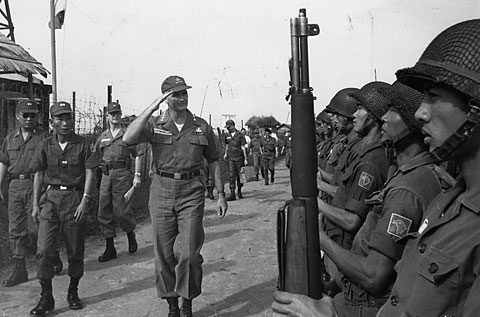
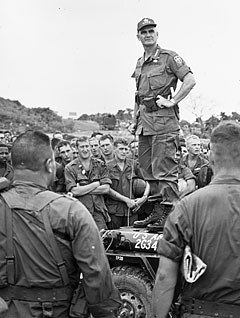 As commander of U.S. forces in Vietnam from June 1964 to 1968, Gen. William C. Westmoreland concentrated single-mindedly on large-scale U.S. conventional operations aimed at the enemy’s main forces. In the process, he neglected two other critically important responsibilities—improvement of South Vietnam’s armed forces and pacification.
As commander of U.S. forces in Vietnam from June 1964 to 1968, Gen. William C. Westmoreland concentrated single-mindedly on large-scale U.S. conventional operations aimed at the enemy’s main forces. In the process, he neglected two other critically important responsibilities—improvement of South Vietnam’s armed forces and pacification.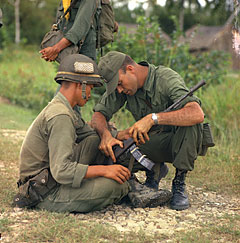 t was not until March 1967 that an allocation of M-16 rifles for the South Vietnamese was reinstated, the first shipments arriving the following month. “But,” said Brig. Gen. James Lawton Collins, Jr., “until 1968 there were only enough to equip the airborne and Marine battalions of the General Reserve.”
t was not until March 1967 that an allocation of M-16 rifles for the South Vietnamese was reinstated, the first shipments arriving the following month. “But,” said Brig. Gen. James Lawton Collins, Jr., “until 1968 there were only enough to equip the airborne and Marine battalions of the General Reserve.”
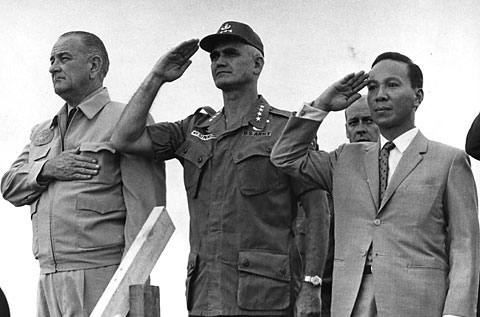 e repeated the claim of having spoken about this matter directly with the President in a subsequent letter to the President’s executive assistant, saying, “The President and I discussed in some detail the importance of modernizing the Vietnamese forces, and I put in a strong plea for accelerating the delivery of M-16 rifles to the Vietnamese. The President was unhappy with the fact that this had been a slow process and gave immediate orders to speed it up.”
e repeated the claim of having spoken about this matter directly with the President in a subsequent letter to the President’s executive assistant, saying, “The President and I discussed in some detail the importance of modernizing the Vietnamese forces, and I put in a strong plea for accelerating the delivery of M-16 rifles to the Vietnamese. The President was unhappy with the fact that this had been a slow process and gave immediate orders to speed it up.”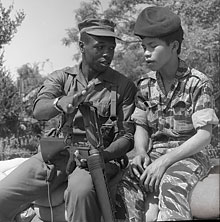 Meanwhile the enemy was energetically and effectively improving virtually the entire arsenal of his forces. “During 1966,” according to a communist history of the war, “many new types of weapons and implements of war were sent to the battlefield, increasing the equipment of main force and local force units.” And: “AK assault rifles were issued to units down to the local force level.”
Meanwhile the enemy was energetically and effectively improving virtually the entire arsenal of his forces. “During 1966,” according to a communist history of the war, “many new types of weapons and implements of war were sent to the battlefield, increasing the equipment of main force and local force units.” And: “AK assault rifles were issued to units down to the local force level.”